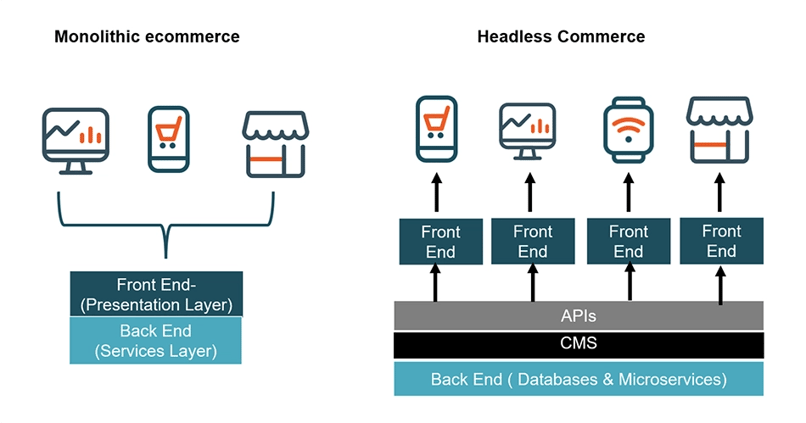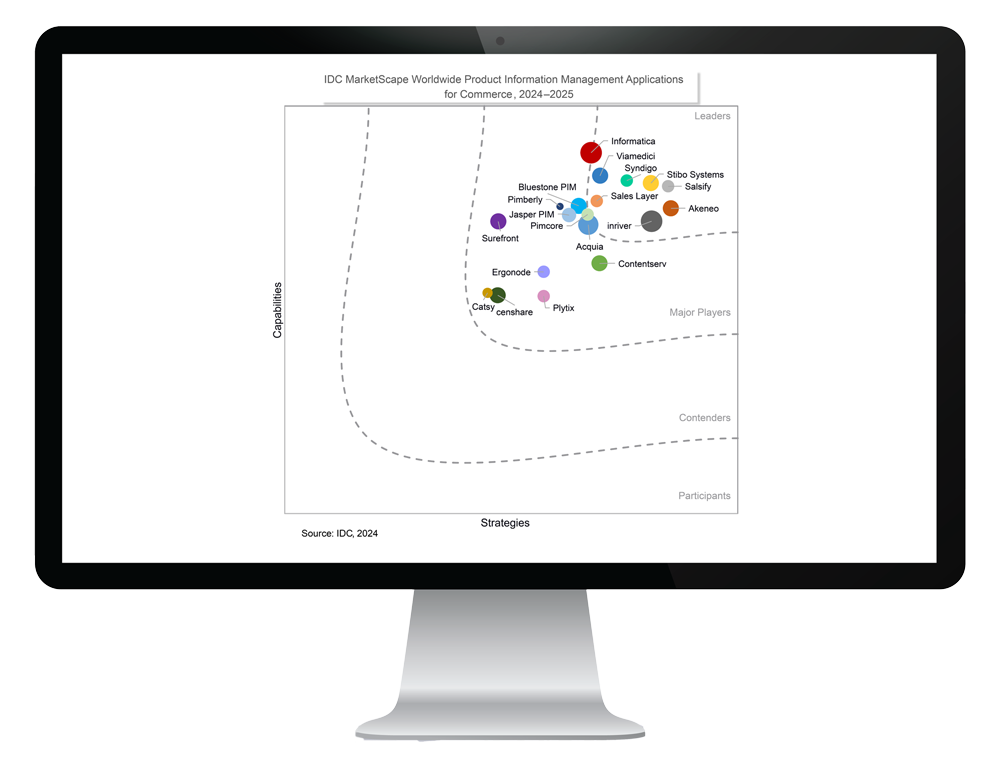Customer centricity has been the focus of retailers for decades. Meeting the customer's needs means much more today than several years ago – now requiring more technology and data orchestration to exceed those expectations. Customers are increasingly realizing that they are in control, wanting convenience, consistency and trust in the information retailers share with them across the various digital and physical touchpoints. Delivering best-in class customer experience focused on personalization and strong end-to-end operational capabilities are core requirements to be successful in this day and age.
During the early growth years of Ecommerce, retailers wanted one package that included everything, every feature, which would deliver a steady and secure ecommerce experience for consumers. In those early days, monolithic ecommerce solutions had both front-end and back-end functionality all in one package. These solutions included all the technologies that connected the website to the key retail tech (ERP, OMS, CMS, PIM, Checkout/POS). Retailers managed all their ecommerce activities within these software platforms. Today, retailers need a different approach, in great part because the number of touchpoints has increased and now more flexibility is needed to orchestrate data flows to the market.
Customer demands are high and loyalty is fleeting
“71% of customers expect personalization … and … 76% of consumers get frustrated when they don’t find it.” – McKinsey Study

What is headless commerce?
Headless commerce is one approach that many retailers are adopting because it separates the customer facing front-end from the business systems on the back-end, to allow for increased flexibility. In other words, the back end of commerce solutions is separated from the direct consumer experience. Headless commerce allows for a more focused approach to the customer experience and leverages integrations to the back-end to improve the ability to provide services. The information flows between the back-end and front-end via Application Programming Interfaces (APIs).

Why are more retailers moving to headless commerce?
Monolithic ecommerce solutions had their place when retailers wanted to have everything built to start selling things online and all capabilities were in one big box. Modern ecommerce often requires a more agile approach. As more data is used on both the back-end and front-end, creating that separation reduces the potential for interruption which would negatively affect the consumer experience. These monolithic solutions are often inflexible when retailers need to pivot, add new channels, or adapt and scale.
Monolithic software solutions may provide an adequate fit and performance for a while, but since they do so many things, some of the features may not be optimized for the retailer or causing the retailer to be locked into a cycle where features are not improving with expected industry standards and as a result, may not best serve their discerning customers.
With everything in one ecommerce package retailers can find themselves beholden to one vendor and the progression of further development to improve ecommerce experience for consumers may be constrained. Larger retailers that compete in categories where excellence in customer experience is a competitive necessity often experience challenges in traditional ecommerce solutions. As a result, many leading retailers and B2C brands have transitioned to headless to deliver a more than an omnichannel shopping options but deliver a personalized and cohesive modern experience that encourages long term loyalty.
REPORT
Stibo Systems Recognized as a Leader in IDC MarketShape: Worldwide PIM Applications for Commerce 2024-2025 Vendor Assessment

Benefits of Headless Commerce:
1. Flexibility with decoupled front-end
Individual applications on the back-end that share data with the front-end can be separated. If there were seven applications as part of the original monolithic ecommerce platform, they now can be invested in at levels appropriate to the priorities of the enterprise. Individual applications can also be more easily shared via API to a wider range of channels creating a more uniform experience with customers.
2. Scalability
With so much data being processed in one solution, the monolith approach is challenged to deliver on the speed and processing requirements needed by retailers today. Separating the front-end from the back-end gives retailer IT teams the flexibility to add more scalability in certain applications that require more data based on customer/market needs. Certain types of applications like B2B customer data may need less constant innovation while B2C data personalization would need constant innovation to maintain relevancy and scalability.
3. Agility to add new channels
While the long-tail assortment was a focus for retailers for many years, now it is about being present wherever customers are, the right place at the right time. As ecommerce expands and is simply called commerce; it now includes mobile commerce (in-app), social commerce, live commerce, metaverse and augmented reality. Headless commerce also enables the coordination and data sharing for supply chain and logistics to meet the consumers’ delivery expectations.
Where do SaaS data management solutions such as Stibo System’s PIM fit into the headless Ecommerce approach?
Along with other systems of record such as ERPs, CMS and OMS solutions; a robust modern PIM is a key component of the back-end for headless commerce strategies.
Key elements of Stibo System’s Modern PIM:
1) Data sourcing
Be assured that all the product data, product content (videos, images, brochures, DIMs, marketing content) are in one place and have been collected for headless commerce needs.
2) Data integration
With strong governance policies and data models, Product MDM can serve as a system of record for all downstream applications.
3) Data enrichment
AI and automation allow for productive and accurate hierarchy placement, content development and improvements over time as markets dictate new information or new attribute needs such as sustainability data.
4) Data sharing
With Stibo Systems’ Product Data Exchange (PDX) and Data as a Service solution, retailers have strong connectivity capabilities that can get the data to the right channels as well as allowing consumers to pull data the way they want consume it.
5) Data evolution
With a configurable platform, Stibo System’s MDM solution gives retailers continuous flexibility to change their data models, workflows, and other ways that they manage product and other master data without labor intensive coding.
With Stibo Systems’ SaaS Product Master Data Management Solution, enterprises can accelerate their digital transformation, support the transformation into headless commerce without product data interruption and get the right product data wherever it is needed to realize your future goals. Learn more about how we support our retail customers.
Stibo Systems has many technological partners in ecommerce, data management, cloud partners and more to support the quick technological agility needed. For more information about our partnership in headless and composable commerce, please check out ours with Fabric.
EXPLORE
Master Data Management for Retailers






































































































































































































